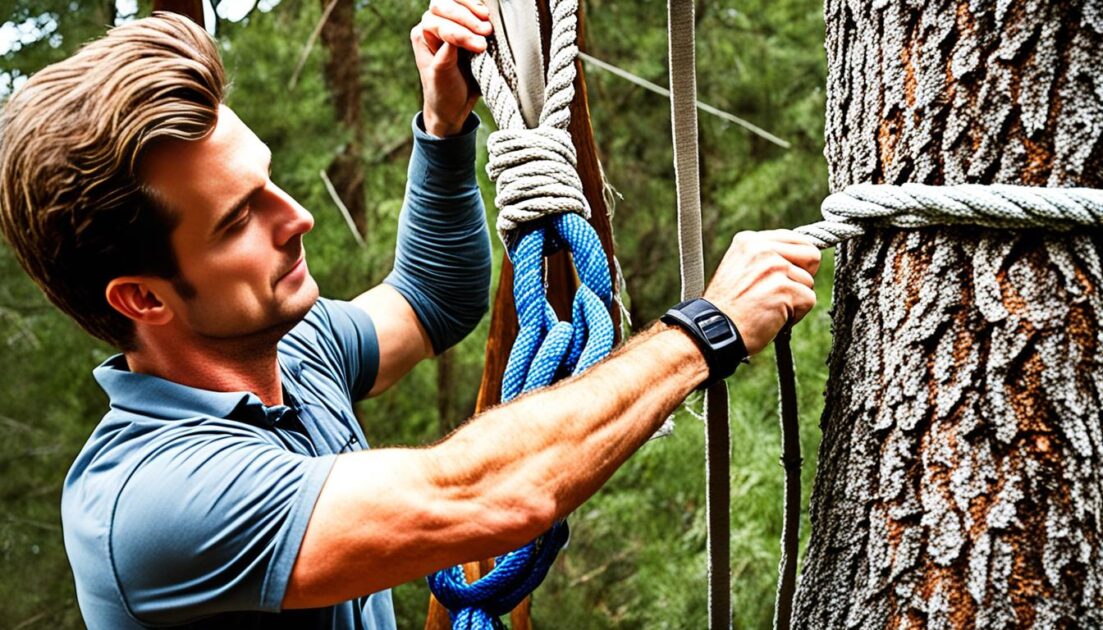Hanging a camping hammock involves more than just tying a few knots. It requires choosing the right location, using tree-friendly straps, and mastering different knot techniques. Proper setup ensures comfort and safety. Hammock camping offers lightweight and portable shelter, elevated sleeping experience, and a deeper connection with nature. The length of a camping hammock ranges from 9 to 13 feet, and the ideal sag is achieved with a gentle curve. Insulating the hammock with underquilts and top quilts or sleeping bags is important for warmth. Proper setup involves choosing a safe location, inspecting equipment, using tree-friendly straps, hanging at the right height, securing straps properly, and testing the stability before use.
Key Takeaways:
- Choose the right location and inspect the equipment when hanging a camping hammock.
- Use tree-friendly straps to minimize impact on trees and ensure a secure hang.
- Achieve the ideal sag with a gentle curve for comfort and proper weight distribution.
- Insulate the hammock with underquilts and top quilts or sleeping bags for warmth during camping.
- Test the stability and security of the setup before using the hammock.
The Benefits of Hammock Camping
When it comes to outdoor adventures, hammock camping offers a unique and enjoyable experience. Compared to traditional tent camping, there are several notable benefits of hammock camping that make it increasingly popular among outdoor enthusiasts.
Exceptional Comfort: One of the major advantages of hammock camping is the comfort it provides. Unlike sleeping on the ground, hammocks keep campers off rough and uneven terrain, ensuring a more restful sleep.
Lightweight and Portable: Hammocks offer a lightweight and compact alternative to tents, making them ideal for backpackers and hikers who value mobility. They are easy to pack and carry, taking up minimal space in your backpack.
Versatility in Camping Locations: Hammocks provide the freedom to camp in various locations, from dense forests to rocky cliffs. Their suspended nature allows you to set up camp in places where tents cannot go, expanding your options for secluded and picturesque campsites.
Enhanced Sleep Quality: The increased suspension of hammocks promotes a cooler night’s sleep, thanks to the improved airflow around your body. This can be especially beneficial during hot summer nights.
Moreover, hammock camping offers a deeper connection with nature. As you sway gently with the rhythm of the wind, you become more attuned to the natural surroundings, allowing you to immerse yourself fully in the beauty of the outdoors.
“Hammock camping offers comfort, portability, and an extraordinary sleeping experience in the great outdoors.”
To further enhance your hammock camping experience, it is essential to have a proper hammock setup guide at your disposal. By following easy camping hammock hanging techniques and utilizing tree-friendly straps, you can ensure a safe and secure setup that minimizes impact on the environment.

| Benefits of Hammock Camping |
|---|
| Exceptional Comfort |
| Lightweight and Portable |
| Versatility in Camping Locations |
| Enhanced Sleep Quality |
| Deeper Connection with Nature |
Tips for Hanging a Hammock in a Tree
When it comes to hanging a hammock in a tree, ensuring a secure and comfortable setup is paramount. These tips will guide you through the process, utilizing effective hammock hanging techniques and suspension methods.
Choose a Safe Spot
Select a location with healthy and sturdy trees to hang your hammock. The trunk diameter should be at least 6 inches to provide adequate support. Avoid trees with broken or dead branches above or below the hammock.
Use Hammock Straps
To protect the trees and minimize damage, opt for hammock straps instead of ropes. Hammock straps distribute the weight evenly across the tree, reducing the risk of causing harm. This eco-friendly approach ensures the longevity of the trees.
Securely Tie the Hammock
Once you have chosen the right spot and employed hammock straps, securely tie the hammock around the tree using the straps. Ensure the knot is tight and reliable to guarantee a stable and safe hanging setup.
Achieve the Proper Sag
Adjust the length of the straps to achieve the perfect sag in your hammock. The ideal sag allows for a gentle curve in the hammock, providing optimal comfort and support. Experiment with the length until you find the desired level of relaxation.
Maintain Safety Precautions
Always prioritize safety when hanging your hammock. Hang it at a safe height, ensuring an appropriate distance from the ground. Regularly inspect the knots and straps to ensure they remain secure and reliable throughout your hammock experience.
By following these hammock hanging techniques and suspension methods, you can enjoy a secure and comfortable hammock setup amidst nature.

Hanging a Hammock Inside
While hammocks are popular for outdoor camping and relaxation, they can also be a wonderful addition to your indoor space. Hanging a hammock inside your home offers a unique and comfortable option for relaxation and leisure.
When it comes to hanging a hammock inside, there are a few options available. You can suspend the hammock from the ceiling using anchor bolts or hooks. This method provides a secure and sturdy hanging point, ensuring your hammock stays in place while you relax. Alternatively, you can use a hammock stand designed for indoor use. These stands are portable and don’t require any drilling or installation, making them a convenient choice for those who want flexibility in hammock placement.
When setting up a hammock inside, it’s important to follow proper safety precautions. Ensure that the chosen anchor points are capable of supporting the weight of the hammock and the user. Check the weight limits and recommendations provided by the hammock manufacturer to ensure a safe and enjoyable experience.
Once your hammock is securely hung inside, you’ll have a cozy and inviting space to relax, read, or take a nap. It can become a focal point in any room and add a touch of relaxation and tranquility to your indoor environment.
Remember to choose a hammock that fits the dimensions of your space and aligns with your interior design aesthetic. A well-placed hammock can enhance the ambiance of your room and create a cozy retreat within your home.

Whether in a living room, bedroom, or even a dedicated relaxation space, hanging a hammock inside can transform your indoor environment into a serene oasis.
Things to Consider When Hanging a Hammock
When it comes to hanging a hammock, there are a few important factors to consider to ensure a safe and comfortable experience. One of the first things to assess is the placement of the trees. Take note of the size and health of the trees to ensure they can support the weight of the hammock. It’s important to choose sturdy, healthy trees with a trunk diameter of at least 6 inches.
Additionally, the location where you plan to hang your hammock should provide adequate space. Make sure there is enough distance between the trees to achieve the proper sag and to avoid any potential collisions with nearby objects. Consider the overhang as well, as you wouldn’t want the hammock obstructing your line of sight or brushing against any branches.
When selecting a site, take into account the noise level and surrounding gardens. Ideally, you’ll want a calm and peaceful spot where you can fully relax. If you’re planning to hang a hammock indoors, think about the available space and anchoring options. Choose a space that can accommodate the hammock’s length and width while also ensuring proper anchoring for safety.
Lastly, it is crucial to choose the right hammock for your specific needs. Determine if you’ll be using it for outdoor camping or indoor relaxation and select a hammock that aligns with your intended use. Whether you’re a seasoned hammock enthusiast or just starting to explore this outdoor lifestyle, considering these factors will help ensure a successful hammocking experience.
FAQ
What are the benefits of hammock camping?
Hammock camping offers lightweight and portable shelter, an elevated sleeping experience, and a deeper connection with nature.
How long is a camping hammock?
The length of a camping hammock typically ranges from 9 to 13 feet.
How should I hang my camping hammock?
Proper setup involves choosing a safe location, inspecting equipment, using tree-friendly straps, hanging at the right height, securing straps properly, and testing the stability before use.
What should I use to insulate my hammock?
Insulating the hammock with underquilts, top quilts, or sleeping bags is important for warmth.
Can I hang a hammock indoors?
Yes, hammocks can be hung indoors for relaxation. They provide a comfortable and space-saving option for indoor lounging.
How do I hang a hammock in a tree?
When hanging a hammock in a tree, it is important to choose a safe spot with healthy and sturdy trees, use tree-friendly straps, and ensure a proper sag by adjusting the length of the straps.
How do I hang a hammock inside my home?
Hammocks can be hung from the ceiling or attached to a stand, offering versatility in placement. It is important to properly anchor the hammock and ensure it can support the weight of the user.
What factors should I consider when hanging a hammock?
Factors to consider include tree placement, site selection, overhang, privacy, space, and anchoring options.

